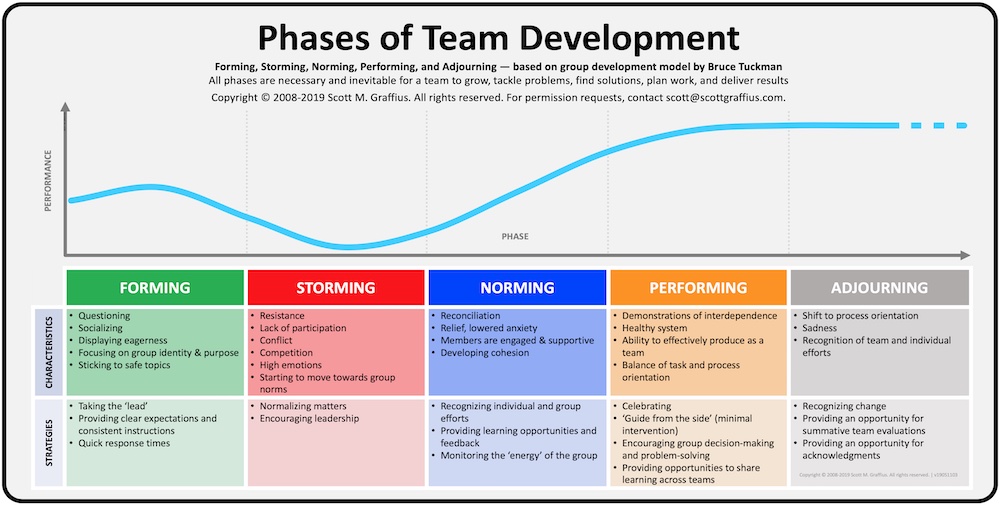These stages supposedly start when the group first meets and last until the project ends. He later added a fifth stage, adjourning, in the 1970s.

Forming Storming Norming Performing Models, Group dynamics and Group
Psychologist, bruce tuckman first came up with the stages of team development model in 1964.

Tuckman forming storming norming. Tuckman's theory focuses on the way in which a team tackles a task from the initial formation of the team through to the. Based on the tuckman model of development. Understanding the continuum of change & engagement.
The model initially consisted of four distinct stages of group formation: In many ways tuckman's model remains relevant particularly to emerging project teams working in phase 1: They go through each stage every time.
The tuckman model describes the phases that groups of individuals go through when they first begin working together as a team. Let’s discuss the stages of team formation and the role of the project manager. 1 bruce tuckman’s forming, storming, norming & performing team development model abstract:
This article aims to explain tuckman’s forming, storming, norming, and performing model of group development. The heightened interest in team development is taking place not just in the academic and research communities. During this stage the leader must be seen to.
Team members naturally behave independently with goodwill towards each other with little or no real trust. Ok to reste, but there's no skipping. The model explains how a team develops over time, which consists of 4 key stages, “forming, storming, norming and performing”.
According to bruce tuckman, team development has five stages: To begin we will look at his original formulation. Forming, storming, norming, performing and adjourning.
Forming, storming, norming, and performing in groups bruce w. Tuckman’s theory was first proposed by psychologist bruce tuckman in 1965. When you understand it, you can help your new team become effective more quickly.
The model was developed in 1965 by bruce tuckman, an american psychologist. It is one of the more known team development theories and has formed the basis of many further ideas since its conception. But that doesn't sound particularly catchy, does it?
Be vigilant in helping them to next stage. Psychologist bruce tuckman, put together a path that groups can follow to get to a high performance phase quicker. Tuckman produced one of the most quoted models of group development in the 1960s.
Forming storming norming performing is one of the most influential ideas in the study of team development. They represent the necessary and inevitable stages from facing challenges, tackling problems, finding solutions and planning work to ultimately delivering. We consider his contribution and the model's continuing use.
In the first phase, forming, teams are uncertain about the team goals and how to work together. Later, a fifth stage was added, called ‘adjourning’ or ‘mourning’. In the second phase, storming, teams challenge boundaries and get to know each other and how to work together.
This model was first developed by bruce tuckman in 1965. Similarities can be seen with other models, such as tannenbaum and schmidt. Bruce tuckman's forming, storming, norming, and performing model describes these stages.
The 'forming, storming, norming, performing' theory is an elegant and helpful explanation of team development and behaviour. Forming, storming, norming and performing. The 5 stages of forming, storming, norming, performing and adjourning that bruce tuckman identified break down as follows:
Each stage is a building block to the next. Not everyone will be at the same stage at the same time. Tuckman, a psychologist at ohio state university, published a theory in 1965 called ‘tuckman’s stages of group development.’.
Each member of the team focuses on the leader, accepting only the leader’s guidance and authority and maintaining a polite but distant relationship with the others. Each of these rhyming stages are aptly named and plays a. Its less catchy title is the tuckman framework, which studies how groups develop and deepen.
It is also widely known as tuckman’s stages of group development. It stated that teams would go through 5 stages of development: This model describes the phases which teams tend to go through from their inception to the successful completion of the project, and highlights the areas which may cause the team and the project to fail.
Team members behave differently in each stage, and the project manager must act accordingly to help them develop. People can find themselves sacrificing their integrity and doing the opposite of their intention. These are known as tuckman stages.
Bruce tuckman, both jointly worked. Dr bruce tuckman published his 'forming, storming, norming, performing' model in 1965. Forming, storming, norming and performing.
Tuckman and his colleagues found there were four stages of team development: Teams are assembled and tasks agreed. The team meets and learns about the.
He documented this in his paper “developmental sequence in small groups” (1965). Time is spent and spent planning, collecting information and bonding. Forming, storming, norming, performing, and adjourning.
Forming a team takes time, and members often go through recognizable stages as they change from being a collection of strangers to a united group with common goals.

TuckmanFormingStormingNormingPerformingmodelTeambuilding Lean
Step 1 Forming Storming Norming & Performing Forming Your Team
Strategies for building your high performance tribe dream team CUInsight

BRUCE TUCKMAN STAGES OF GROUP DEVELOPMENT PDF

Forming Storming Norming Performing Exceptional PPM and PMO Solutions